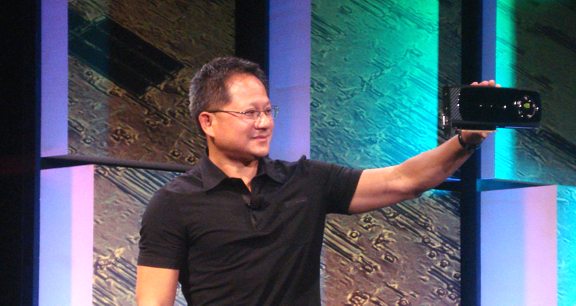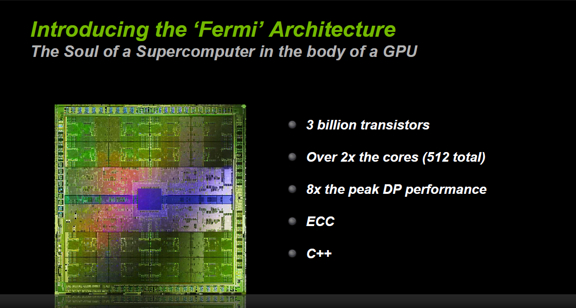Latest News
October 12, 2009

On Wednesday October 31, at NVIDIA GPU Technology Conference in San Jose, California, when NVIDIA’s president and cofounder Jen-Hsun Huang held an upcoming product codenamed Fermi, he described it to the cheering audience as “the soul of a super computer in the body of a GPU.” What he held in his hand, he said, was, “not a GPU that has been extended for general purpose computing” but “a brand new architecture designed from the ground up to be a computer first … [that treats] computer graphics and parallel computing as equal citizens.”
Since the release of CUDA, its programming architecture, NVIDIA has been advocating the use of GPU’s parallel computing power not only for graphics-related tasks but for general purpose computing tasks, from analyzing finantial markets and estimating radiotherapy dosages to studying black holes.
NVIDIA’s lastest GPU, Tesla, comes with 240 CUDA computing cores. Fermi, NVIDIA’s next-generation architecture, comes with 512 cores—more than twice the number found in Tesla. In engineering, the increased horsepower of GPU has made it possible to produce real-time ray-tracing and run finite-element analysis at a reasonable cost. Fermi’s debut promises even faster, cheapter ways to accomplish the same tasks, which are considered critical to digital prototyping (the practice of using a 3D digital replica for many of the operations where manufacturers have previously used a physical prototype).

CPU maker Intel’s effort to counter the GPU’s territorial advances can be seen in the carefully-shielded development of Intel’s new chip, codenamed Larrabee. According to the chip maker’s own description, Larrabee is designed “to meet the increasing compute and memory intensive demands of the latest PC games and high-performance computing applications, such as image processing, physical simulation, and medical and financial analytics.”
Future generations of GPUs and CPUs may not be confined to dual-core or quad-core. As seen with NVIDIA GPUs, they extend to chips comprising many cores. (To call them “multi-core” doesn’t seem to do justice. I’m tempted to call them “plethora-core.”)
The rise of such chips signals a dramatic shift in not only in the GPU market but also in the CPU market. Once GPU starts to take on many of the computing tasks that used to be perform by a CPU, the “G,” which stands for “Graphics,” in the acronym, begins to look like a misnomer. In the near future, the line between GPU and CPU will continue to blur, with the graphics chips becoming an alternative processing chip.
Fermi and Larrabee (when it does become available) may also change the landscape of high-performance computing (HPC). Because of the significant boost in computing power available from a single chip, smaller HPC clusters will likely produce the same processing power currently attainable only by large server farms.
For more on NVIDIA GPU Technology Conference, read “Dispatches from NVIDIA GPU Technology Conference,” Oct. 8, 2009.
For more on Fermi, watch the video clip below, provided by NVIDIA:
Subscribe to our FREE magazine, FREE email newsletters or both!
Latest News
About the Author
Kenneth Wong is Digital Engineering’s resident blogger and senior editor. Email him at [email protected] or share your thoughts on this article at digitaleng.news/facebook.
Follow DE





